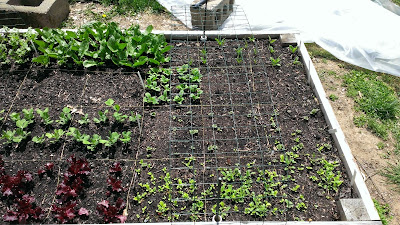I Know Better
Composting...
2014 started off a bit slow. The winter would NOT go away. We had record amounts of snow fall, record low temperatures, and a freeze that would not quit. I was excited this year, because I was going to be using compost from my very own supply. 2 years of yard waste, fall leaves and food scraps were cooking for a long time and this was the year I was going to introduce it to my garden. The beneficiaries were to be the two 4'x4' beds (the 2nd eldest in the family). I loaded my wheel barrow 3 or 4 times and topped off the beds with the sweet smelling darkish brown GOLD...my very own recipe! I have been waiting for this opportunity for years now and here it is. I sowed a bunch of seeds: bunching onions (scallions) Champion radish, French Breakfast radish, mustard, Lola Rosa lettuce, arugula and Corvair spinach in the first 4x4.
In 4x4 #2, more scallions, Kaleidoscope carrots, sweet carrots, Bright Lights Swiss chard, Gailon (hybrid kale/broccoli) and Razzle Dazzle spinach. I also popped in radishes in between rows here and there.
My excitement was high. I believed that this would be my best start yet. Then I began to notice seedlings popping up everywhere (even where I did not sow anything). They all looked the same and so it dawned on me that my compost may have been filled with weed seeds. So I went to my compost bin and sure enough, COVERED with weed seedlings. I realized that a large portion of my compost pile was grass clippings (my lawn is not weed free). The pile was filled through and through with the little budding plants that are now filling my raised beds. I KNOW BETTER! I have listen to my boy Mr. McGrath time and time again say that lawn clippings should stay on the lawn, and weeds that have gone to seed should be discarded. I failed to heed that advice and henceforth contaminated my beds with TONS of weeds. Once again, you live and you learn.
 Never the less, my beds are doing fine now. They require constant weeding, but it gets easier as the weeds grow larger. As you can see below, I also added some strawberry plants and marigolds (to keep the bad buggies away). This bed will likely be a strawberry patch next season...planning ahead.
Never the less, my beds are doing fine now. They require constant weeding, but it gets easier as the weeds grow larger. As you can see below, I also added some strawberry plants and marigolds (to keep the bad buggies away). This bed will likely be a strawberry patch next season...planning ahead.
 Here, this bed is doing fine with marigolds, leafy greens and radishes popping out everywhere. One thing I can say is that I have had 0.00 luck with Razzle Dazzle spinach. I cannot seem to get it to grown with any fervor. There are plenty of varieties of spinach and Corvair kicks ass in my garden...so THERE!
Here, this bed is doing fine with marigolds, leafy greens and radishes popping out everywhere. One thing I can say is that I have had 0.00 luck with Razzle Dazzle spinach. I cannot seem to get it to grown with any fervor. There are plenty of varieties of spinach and Corvair kicks ass in my garden...so THERE!
As of March this year, my two compost bins are FILLED, 4'x3'x3' with fall leaves, coffee grinds and a splash of grass clippings. That should cook up quite well and be void of any weeds come time to add it to my beds. That time could not come quick enough. I am ripe with enthusiasm for this batch of compost. Time will tell. DAMN WEEDS!
In 4x4 #2, more scallions, Kaleidoscope carrots, sweet carrots, Bright Lights Swiss chard, Gailon (hybrid kale/broccoli) and Razzle Dazzle spinach. I also popped in radishes in between rows here and there.
 Never the less, my beds are doing fine now. They require constant weeding, but it gets easier as the weeds grow larger. As you can see below, I also added some strawberry plants and marigolds (to keep the bad buggies away). This bed will likely be a strawberry patch next season...planning ahead.
Never the less, my beds are doing fine now. They require constant weeding, but it gets easier as the weeds grow larger. As you can see below, I also added some strawberry plants and marigolds (to keep the bad buggies away). This bed will likely be a strawberry patch next season...planning ahead.  Here, this bed is doing fine with marigolds, leafy greens and radishes popping out everywhere. One thing I can say is that I have had 0.00 luck with Razzle Dazzle spinach. I cannot seem to get it to grown with any fervor. There are plenty of varieties of spinach and Corvair kicks ass in my garden...so THERE!
Here, this bed is doing fine with marigolds, leafy greens and radishes popping out everywhere. One thing I can say is that I have had 0.00 luck with Razzle Dazzle spinach. I cannot seem to get it to grown with any fervor. There are plenty of varieties of spinach and Corvair kicks ass in my garden...so THERE!As of March this year, my two compost bins are FILLED, 4'x3'x3' with fall leaves, coffee grinds and a splash of grass clippings. That should cook up quite well and be void of any weeds come time to add it to my beds. That time could not come quick enough. I am ripe with enthusiasm for this batch of compost. Time will tell. DAMN WEEDS!











































